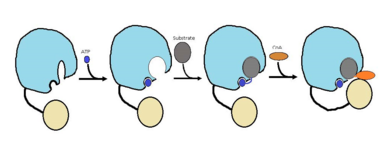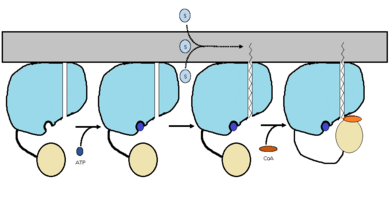Sandbox Reserved 1063
From Proteopedia
(Difference between revisions)
| Line 16: | Line 16: | ||
FadD13 has a distinct hydrophobic tunnel that starts at the active site and is capped by the positively charged surface patch.The <scene name='69/694230/Fadd13_subunits/13'>hydrophobic tunnel</scene> is found inside the N-terminal domain. It is composed of six beta sheets (beta 9-14) shown in green and two alpha helices (alpha 8-9) shown in red.The hydrophobic tunnel allows large lipids/fatty acids, up to 26 carbons, to bind. | FadD13 has a distinct hydrophobic tunnel that starts at the active site and is capped by the positively charged surface patch.The <scene name='69/694230/Fadd13_subunits/13'>hydrophobic tunnel</scene> is found inside the N-terminal domain. It is composed of six beta sheets (beta 9-14) shown in green and two alpha helices (alpha 8-9) shown in red.The hydrophobic tunnel allows large lipids/fatty acids, up to 26 carbons, to bind. | ||
===Surface Patch=== | ===Surface Patch=== | ||
| - | FadD13 has an arginine and aromatic rich surface patch that allows it to be a [http://en.wikipedia.org/wiki/Peripheral_membrane_protein peripheral-membrane protein]<ref>PMID: 20027301</ref>.The hydrophobic tunnel is capped by the arginine and aromatic rich <scene name='69/694230/Fadd13_subunits/14'>lid loop</scene> shown in yellow that is involved in the peripheral binding of the enzyme to the membrane. Based on the structural information present and biochemical information, it is likely that the lid loop opens up upon contact with the membrane. This would allow for the substrate to bind and have the lipid tail to reside in the membrane during catalysis (figure 2). Six key arginine residues, <scene name='69/694230/Fadd13_subunits/15'>Arg 9, 17, 195, 197, 199, and 244</scene> create a positively charged surface that is likely involved in initially recruiting FadD13 to the membrane. When these residues were replaced with hyrdrophobic alanine residues, membrane binding increased. This points to the important role of hydrophobic interactions in keeping the protein bound at the membrane<ref>PMID: 22560731</ref>. | + | FadD13 has an arginine and aromatic rich surface patch that allows it to be a [http://en.wikipedia.org/wiki/Peripheral_membrane_protein peripheral-membrane protein]<ref>PMID: 20027301</ref>.The hydrophobic tunnel is capped by the arginine and aromatic rich <scene name='69/694230/Fadd13_subunits/14'>lid loop</scene> shown in yellow that is involved in the peripheral binding of the enzyme to the membrane. Based on the structural information present and biochemical information, it is likely that the lid loop opens up upon contact with the membrane. This would allow for the substrate to bind and have the lipid tail to reside in the membrane during catalysis (figure 2). Six key arginine residues, <scene name='69/694230/Fadd13_subunits/15'>Arg 9, 17, 195, 197, 199, and 244</scene> create a positively charged surface that is likely involved in initially recruiting FadD13 to the membrane. When these residues were replaced with hyrdrophobic alanine residues, membrane binding increased. This points to the important role of hydrophobic interactions in keeping the protein bound at the membrane<ref name="Anderson 2012">PMID: 22560731</ref>. |
| - | [[Image:Proposed Mechanism.png|390 px|thumb|left|Figure 2 shows the proposed mechanism for an ACSVL protein bound to the membrane<ref | + | [[Image:Proposed Mechanism.png|390 px|thumb|left|Figure 2 shows the proposed mechanism for an ACSVL protein bound to the membrane<ref name="Anderson 2012"/>]] |
== Function == | == Function == | ||
Revision as of 17:39, 21 April 2015
FadD13
| |||||||||||
References
- ↑ Watkins PA, Maiguel D, Jia Z, Pevsner J. Evidence for 26 distinct acyl-coenzyme A synthetase genes in the human genome. J Lipid Res. 2007 Dec;48(12):2736-50. Epub 2007 Aug 30. PMID:17762044 doi:http://dx.doi.org/M700378-JLR200
- ↑ Kochan G, Pilka ES, von Delft F, Oppermann U, Yue WW. Structural snapshots for the conformation-dependent catalysis by human medium-chain acyl-coenzyme A synthetase ACSM2A. J Mol Biol. 2009 May 22;388(5):997-1008. Epub 2009 Apr 1. PMID:19345228 doi:10.1016/j.jmb.2009.03.064
- ↑ Khare G, Gupta V, Gupta RK, Gupta R, Bhat R, Tyagi AK. Dissecting the role of critical residues and substrate preference of a Fatty Acyl-CoA Synthetase (FadD13) of Mycobacterium tuberculosis. PLoS One. 2009 Dec 21;4(12):e8387. doi: 10.1371/journal.pone.0008387. PMID:20027301 doi:10.1371/journal.pone.0008387
- ↑ Khare G, Gupta V, Gupta RK, Gupta R, Bhat R, Tyagi AK. Dissecting the role of critical residues and substrate preference of a Fatty Acyl-CoA Synthetase (FadD13) of Mycobacterium tuberculosis. PLoS One. 2009 Dec 21;4(12):e8387. doi: 10.1371/journal.pone.0008387. PMID:20027301 doi:10.1371/journal.pone.0008387
- ↑ 5.0 5.1 Andersson CS, Lundgren CA, Magnusdottir A, Ge C, Wieslander A, Molina DM, Hogbom M. The Mycobacterium tuberculosis Very-Long-Chain Fatty Acyl-CoA Synthetase: Structural Basis for Housing Lipid Substrates Longer than the Enzyme. Structure. 2012 May 2. PMID:22560731 doi:10.1016/j.str.2012.03.012


